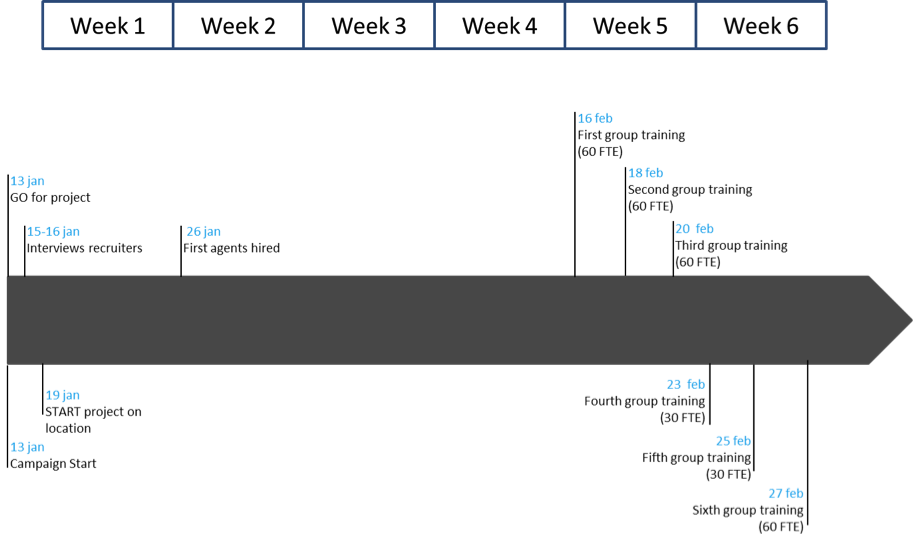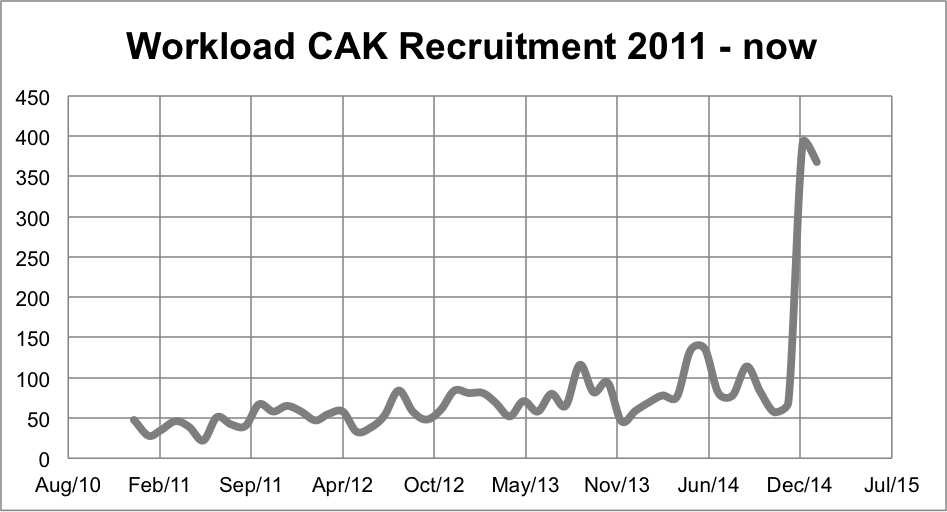Hire hundreds of people, faster than we ever have, with no decrease in quality.
That was our task, and we completed it.
Let me tell you our story.
A Super-quick Overview of Why This Happened
OK, in brief, here goes: In January 2015 a whole new set of laws and regulations applied to healthcare in the Netherlands. CAK, the organization I work for, plays a central role in this field on behalf of the government. What we do basically is charge mandatory contributions for healthcare that people consume. Therefore we collect data from over 3,500 so called “chain partners” (healthcare institutions, other government institutions, etc.). As a result of these changes in laws and regulations the height and composition of the contributions differs significantly from prior to 2015.
This all meant more calls for our customer call center, and in eight weeks we’d need about 300 full-time call-center agents.
These were 300 full-time employees who:
- we could give a tenure commitment of eight weeks maximum
- had to be recruited with a predominantly new team (7 out of 10)
- needed to be trained before deployment
- needed to be located in a new location (around 45 miles from the existing office, a lot for Dutch standards)
- had to be recruited in an unknown labor market region
The number of 300 hires in so little time was quite unprecedented within our organization (see graphic above) as we were used to dealing with a monthly average workload of around 80 reqs over the last four years. For this project that would skyrocket to just under 400.
Although there were only five weeks available for completing this task, there were no concessions to be made in quality. That’s why we decided to hold on to the existing process (see picture below) and somehow squeeze it in the amount of time we were granted.

Thrilled But Nervous
The moment we heard of this project we really hoped it was going to go through, because this is the kind of assignment one becomes a recruiter for; this is where a difference is truly made. When I discussed this project and the implications, my team responded in a way that gave me very strong confidence in success, should we be asked to do this. The moment we got the “go” on Tuesday, January 13, we were thrilled. The campaign was started immediately. All measures were taken to have the new location ready. We set out to build the recruitment team that was bound to be operational the following Monday.
I basically had three concerns: would we be able to bring in the right amount of candidates, given the eight-week commitment and the unknown labor market we’d be campaigning in? Would candidates be motivated enough to come over three times during the process for this kind of project? And how would a predominantly rookie team cope with this challenge and the instant productivity it would ask from them?
Based on a few smaller projects we did in 2014, we had a hunch in terms of conversion rates, and projected we would need around 2,400 candidates to fill 300 seats. The conversions would somewhat look like this:

The Need for Speed
We didn’t know to what extent potential candidates would be attracted to us and the job we had to offer, especially in a market in which we are virtually unknown as an employer. Luckily we had a head start of five days, but by the time Monday had arrived we only had around 300 candidates, based on a full-swing campaign that involved almost every job board, an AdWords campaign that outran the traffic Google could produce, and an all-out Indeed CPC campaign. We also called upon all of our call-center colleagues to help us as well by sharing and bringing in referrals.
Surprisingly enough, the team that had started Monday, January 19, and had spent most of the day absorbing information about CAK and the project, indicated they needed more candidates really soon by the end of that same Monday. One concern down, two to go, I remember thinking, and immediately ordered a few extra targeted mailings.
Speed was, of course, crucial for success given the fact that we had only four weeks to deliver 180 full-time employees who would start their training in three batches in week five (see schedule below) and another 120 in week six.

In the course of the first two weeks we could see the quality of the CPC traffic (both Google and Indeed) go up, but we still needed many more candidates. Luckily a company called Young Capital, a staffing company by nature, offered to help out with mailings and banners on its website. It turned out to be able to reach the right audience for this project (university students mainly) and this gave an enormous boost to the campaign with a high-quality pipeline as a result. Although we did some additional labor market actions later on in the project, in retrospect it hadn’t been necessary.

Due to the increasing pipeline quality, this is what the conversion rates looked like at the end of the project:
 Will They Show?
Will They Show?
During the project we closely monitored for signs of candidates complaining about having to come over three times during the recruitment process for such a short project. Whether it’s because of relatively high unemployment in the region or the relatively high hourly wage we don’t know, but there were no signals whatsoever.
Another thing to watch was the gap of almost three weeks between the first hires and the start of the training. We figured some would dropout, but 59 out of 60 hires actually started the first training on February 16. The high commitment our hires showed, combined with the increasing quality of the pipeline, meant we only needed 1,851 candidates instead of 2,400 to get to 300 full-time employees. The average working week per candidate contained approximately 5 percent more hours than expected, so we only needed to hire 288 agents to reach 300.
Having two recruiters of my core team on site was essential for the administrative handling, the ties with the CAK organization, and tackling any unforeseen operational questions or hiccups that would pop up. Decisions were made quickly to prevent delay. Every change in process that was important for the entire team was discussed in the kickoff meeting we started with every day. Best practices were exchanged in this daily kickoff as well.
We Did It
Yes, we did hire all agents in time. More important though, the feedback we got from both trainers and team leads proved we actually hired excellent quality. And we had a 10 percent dropout rate in the first two weeks, which is very acceptable.
The agents digested around 37,000 calls in the first week with a 97 percent reachability (which, I’m told, is superb). So our clients were served as they should be. Moreover, this project prevented us from making the evening news.
We Learned Something
- Combining quality hires with speed is possible
- Putting two recruiters from the core team to the project team is crucial for the corporate connection and administrative accuracy
- A targeted mailing is a very strong tool for this kind of project
- Job seekers in the Amsterdam region are very motivated finding a new job
- Hiring senior recruiters helped the project get up to speed very quickly
